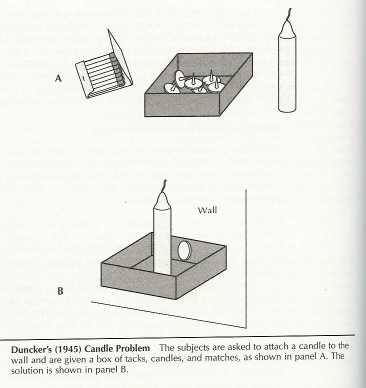10.5 Identifying and Overcoming Problem-Solving Barriers
The 9 Dot Problem
Here is another popular type of puzzle that challenges your spatial reasoning skills. Connect all nine dots with four connecting straight lines without lifting your pencil from the paper (Mayer, 1992).

Did you figure it out?
Solve the puzzle with 4 contiguous segments:

Now, solve the puzzle with just 3 contiguous segments!

Remember, the way that a person understands and organizes information provided in a problem or represents a problem often facilitates or hinders problem solving. If information is misunderstood, thought about, or used inappropriately, then mistakes are likely – if indeed the problem can be solved at all.
So we not only metaphorically, but sometimes literally, want to “think outside the box” to facilitate creative problem solving. Until we had this insight with the problem, we were having “representation failure.”
Put differently, there were obstacles in problem representation, the way that a person understands and organizes information provided in a problem. Initially, we were understanding and organizing information the information in a manner that hindered successful problem solving.
Likely related to our initial representation failure, we likely made the unwarranted assumption or unwarranted expectation that we needed to stay inside some imaginary box. Note that in some contexts, we do want to stay inside some imaginary box. Further, we often have a history of parents and teachers encouraging us to stay inside the lines, leading to a negative transfer of learning in which past learning or training negatively impacts performance on new tasks.
If information is misunderstood or used inappropriately and/or unwarranted assumptions are made, then mistakes are likely – if indeed the problem can be solved at all. With the nine-dot matrix problem, for example, construing the instruction to draw four lines as meaning “draw four lines entirely within the imaginary box matrix” means that the problem simply could not be solved.
Mental Set
A mental set is where you persist in approaching a problem in a way that has worked in the past but is clearly not working now.
In the example of the Nine-Dot Problem described above, students often tried one solution after another, but each solution was constrained by being stuck or set in their way of thinking about and response not to extend any line beyond the matrix of an imaginary box.
Imagine a person in a room that has four doorways. One doorway that has always been open in the past is now locked. The person, accustomed to exiting the room by that particular doorway, keeps trying to get out through the same doorway even though the other three doorways are open. The person is stuck, but she just needs to go to another doorway instead of trying to get out through the locked door.
Functional Fixedness
Functional fixedness is a type of mental set where you do not consider using something for a purpose other than what it was designed for or is typically used for.
Functional fixedness concerns the solution of object-use problems. The basic idea is that when the usual way of using an object is emphasized, it will be far more difficult for a person to use that object in a novel manner. An example of this effect of being fixed on the typical use of objects is Duncker’s (1945) candle problem.
Imagine you are given a box of matches, some candles and tacks. On the wall of the room there is a corkboard. Your task is to fix the candle to the corkboard in such a way that no wax will drop on the floor when the candle is lit. – Got an idea?
Explanation: The clue is just the following. When people are confronted with a problem and given certain objects to solve it, it is difficult for them to figure out that they could use them in a different (not so familiar or obvious) ways.

In this example the box needs to be recognized as a support for the candle rather than as a container. People tend to be stuck or fixed on the box as a container, and not think of or notice other uses or functions (like to support a candle).
Until we had this insight with the Candle Problem, we were having “representation failure”, or we were understanding and organizing information the information in a manner that hindered successful problem solving.
Likely related to our initial representation failure, we likely made the unwarranted assumption or unwarranted expectation that we needed to think about and use the box as a container (only).
Examples
Check out this Apollo 13 scene where the group of NASA engineers are given the task of overcoming unwarranted assumptions and overcoming functional fixedness. (1+ min.)
Finally, check this link as an interesting way to review some of these concepts and relate them to your life.
https://prezi.com/3o1o7yqdsabl/functional-fixedness/
A process in which previous learning obstructs or interferes with present learning. For instance, tennis players who learn racquetball must often unlearn their tendency to take huge, muscular swings with the shoulder and upper arm.
A temporary readiness to perform certain psychological functions that influences the response to a situation or stimulus, such as the tendency to apply a previously successful technique in solving a new problem.
The tendency to perceive an object only in terms of its most common (or intended) use.

